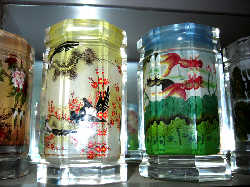 Theme
Theme
 Interior painting subjects range from flowers and birds, to clouds and waterfalls, to historical figures and stories, which are shown vividly in the works. The art, therefore, was dubbed "the work ofghosts and gods", winning the hearts of the royals and nobles of the Qing Dynasty.
Interior painting subjects range from flowers and birds, to clouds and waterfalls, to historical figures and stories, which are shown vividly in the works. The art, therefore, was dubbed "the work ofghosts and gods", winning the hearts of the royals and nobles of the Qing Dynasty.
The most interesting characteristic of Chinese art is the implication of its paintings. The themes usually come from Chinese folk legends, historical stories, religion and philosophy (Confucianism, Taoism and ChineseBuddhism). The painted subjects are not purely decorative: Usually they indicate good wishes and people's expectations for good fortune and happiness, justice, good crops, health and longevity. It is believed that a snuff bottle with a painted Taoist magical figure can protect the master from danger.
 Schools
Schools
There are mainly three schools of interior-painted snuff bottles:
1) Jing (Beijing) School:
Artists of this school are generally highly accomplished in literature and the arts and their artworks have a strong literary flavor with profound connotations and an array of artistic concepts.
2) Lu (Shandong) School:
Subjects from this school include the 108 Liangshan heroes, horses, beasts, etc, and their works often have a heroic flavor with bright, local characteristics.
3) Ji (Hebei) School
Interior paintings of the Ji School are mainly portraits, featuring far-reaching concepts as well as a subtle layout.
Each of the three interior-painting schools has its individual characteristics and unique styles, with the Ji School playing the most important role in promoting interior paintings. Hengshui, a county inHebei province, is known as the home of interior painting.
